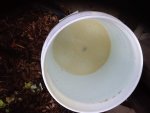Good morning, Draco. I am just catching up with your thread as ive been a bit sidelined lately.. Since you're in full-on-solve mode this season, i will share ideas with you as needed over the next little while - but know that many of my comments here are best categorized as experimental

Most pressing to my mind is to try to identify for certain the source and confirm iron, because otherwise, were flying a bit blind on solutions (apart from sequestering.)
First off, I think its worth getting at least the Lamotte Iron/copper instatest kit so that you can attempt to check "free" iron ppm as it falls out of solution and measure your tap water. Its fairly inexpensive. We should also check to see if you have a copper reading at all. There are beefier metal test kits that will read better, bu this would get you started.
Do you have a pool heater? If so, add your make and model so we know if the exchanger is copper.
Now, just a couple of things that might help going forward...first off, just so you know, any filter, and for that matter, any sequestrant product, is effective in proportion to the metal load it must treat. So for example, someone who once tested a prefresh filter at a slow flo rate removed 1.4 ppm of two...but .6 ppm still stains. Which is why filtering alone is often never enough in high iron loads. Metal trap uses green sand, and is fairly expensive IMHO, and only rated for a certain number of gallons, after which it is spent. The green sand itself also contains magnesium, and right, wrong or irrational, I never used it for fear of somehow loading any extra mag in my water, as my well also has mag

It is possible, depending on which size, that yours was "spent" before you were filled entirely. But its also possible that trace iron in your salt, a highly galvanic condition in swg, etc. is playing into the equation, though this might be controversial.
For oxidized metal, I've seen good reports on the slime bag, because it goes down to 1 micron. 1 micron sized filters are best at getting more iron out...but none will get all, just so you know. For exampe, I now use only softened water plumbed to the pool spigot...that gets me from 2 ppm to .5. Then I use a pre filter crafted from a 10" Pentek housing with 1 micron disposable filter. That gets me down to about .2ish these days...but I'm swg and I still use Jacks...just much less of it than I used to

Jacks techs believe that some sequestered metal will in fact be filtered out if your calcium rate is at 200, btw. I cannot prove this is true, but I am going to tell you later about a couple of extreme calcium-related strategies that I want you to research carefully and try at your own risk later in the season and only if you're comfortable -- and I will get you in contact with someone who has actually done the calcium treatment after I pm that poster for permission

But first, lets try to rule out any exacerbating phenom, which can be tricky, because these things may or may not be related to your metal load, but I'm trying to get a full picture based on other metal threads over a few years

For example, can you confirm a) that your swg is bonded (you'll see bare copper bond wire connected to your equipment) and b) that there's no other metal parts corroding into the pool, eg ladder, light, etc. and c) that if you have a heater, there are no signs of corrosion at the heat exchanger (remove panel and look for any sign of small drip line that has turned green on the sides.) and d) whether or not you had a sacrificial anode installed with the swg
Try to test or get your source water tested for both iron and copper.
Once we've checked all these things, I will share two highly experimental aproaches to ultimate metal reduction ...one involving a few weeks or careful steps to use cacium as a removal agent, and the other using specifically alum floc IF you have a multiport valve on your sand filter and can filter to waste after a manual vac. I've a bit of experimental experience with the latter.
In the mean time, give the pool as much jacks as it needs to stay clear...high load levels require high sequestrant levels. Eg. I once did a 5 bottle treatment with Metal Magic on my 23k gallon pool and it actually lifted stains as well as sequestered the metal.



